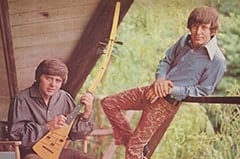
Photos by Ric Klein
There are several kinds of Monkees. There are Screen Gems set Monkees, concert Monkees, interview Monkees, and recording session Monkees. This article is about the latter, by two young men who should know. This article is also about the two young men, whom you should know.
THE MONKEES: By Tommy Boyce and Bobby Hart (songwriters and producers of “Last Train to Clarksville,” “I Wanna Be Free,” “She,” the Monkees’ theme—to name just a few!)
About a year and a half ago Screen Gems studios gave us a TV script which was being considered for a pilot. We thought it was a smash show, but no one else was really very interested. It was spelled Monkeys then, with a “y.” This was before they ever picked the four guys to play the Monkees. Anyway, the producers needed three songs for the pilot, so we dropped most of our other projects and spent eight months working on that show. We ended up singing the Monkees theme on the pilot show because there wasn’t enough time for the Monkees to record it!
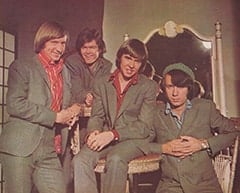
Once the show started, we continued writing songs and producing them, so were sort of the first people to work with them in a recording studio. We’d go into the studio with the Monkees about 1 in the afternoon and go till 4 in the morning sometimes. This was on Saturday and Sunday only—they were filming during the week. We had to cut two albums right away, plus two songs for every show. It wasn’t easy!
Usually we’d take Micky (who sang most of the leads) into the studio first for a half hour or so and teach him the song we were going to record. Then he’d sing it, just like that. He’s a very quick learner, almost unbelievable.
That’s the way we did it at first because of the time problem—the instrumentals would be recorded first. Some were cut in New York with Jeff Barry producing (Jeff is Neil Diamond’s producer), and some were done out here by a group called the Candy Store Prophets (more about them later).
The Monkees have just started doing their own instrumentals—Chip Douglas has cut a few sides with them playing and singing.
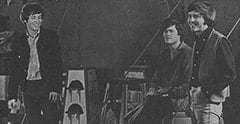
What’s a Monkee session like? Well… pretty wild! Everybody goofs around some of the time. If there are two or more in the studio at one time, look out! If Davy and Micky are turned loose together, forget it. They’re so funny no one wants to stop them. They go into whole comedy routines, all ad lib; they just start cracking jokes back and forth. One time, right in the middle of a song, Micky started off about a safari in Africa, where he’d supposedly “played cards with the natives.” “Zulus?” Davy asked. “No, I won,” Micky shot back.
And it’s all off the top of their heads! We have several hours of comedy bits on tape—we’d just let the tape machine play on while they were cutting up.
Another time, right in the middle of a song (that’s when most of this happens, never before or after a song!), Davy called out, “Got a glass of water?” Micky said, “Why, are you thirsty?” “No, I want to see if my neck leaks!” Davy answered.
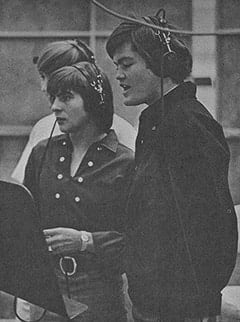
And the voices and noises they come up with… Micky has a million voices. One time he did a ten-minute impersonation of Jonathan Winters. When we were recording “Last Train to Clarksville” Micky stopped in the middle (where else?) and started this whole skit about a spaceman from Mars, making weird sounds into the microphone. Davy picked up on it and started making noises of his own, like a bomb being tossed and exploding into the microphone. They’re crazy!
And usually, while all this is going on, Peter is sitting quietly in some corner reading a book or the Free Press (a liberal Los Angeles newspaper).
Mike goofs around too once in while, but he’s usually intent on getting things done and getting out into his scene—home, family, folk music clubs. I understand he hangs out at the Troubadour whenever he can. He used to work there before becoming a Monkee.
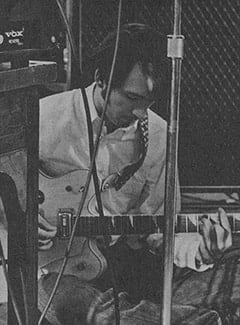
There’s a funny story—that is, we think it’s funny—that started back when we first began recording the Monkees. One Saturday or Sunday we arrived at RCA studios and saw hundreds of girls hanging around outside. It seems the Rolling Stones were recording there too. We walked on through with the four Monkees, completely unknown. We stopped and talked to a couple of girls, introduced them to Micky, Davy, and so on, and told them about the TV show. They couldn’t have cared less. We said something like, “In a few months you’ll be here waiting to see these guys.” They laughed. Now the Monkees have to sneak into those same studios, and we often wonder if those same girls are out front waiting; if they are, we’ll bet they’re not laughing!
But about the Stones thing—when the Monkees gave a concert in Phoenix, Arizona, in January we heard (we don’t know if it’s true or not) that the Stones were in town too and tried to get backstage to see the Monkees. They never made it because the guards didn’t believe they were really the Stones and refused to let them through. Sort of ironic, don’t you think?
You want us to characterize each Monkee in a few words? That’s always hard to do, because there’s so much you can say about anybody, especially those four. Generally, they’re very easy to work with. We became friends with them, so it’s one big get-together when we record. That helps.
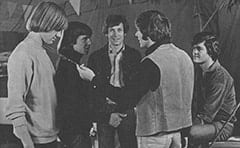
Davy. Davy is a funny guy. He’s always nicely dressed, very clothes conscious. I picture him at home, alone, relaxing—but impeccably dressed. He’s the Mr. Show Business of the four, the one who’s “on” and keeps up an image at all times. His background on the stage probably accounts for a lot of that.
Micky digs everybody and wants everybody to dig him. Very sincere, even when he’s making your stomach hurt from laughter. He’s anxious to make people happy, like the time he roller skated into a crowd of about 400 girls bcause [sic] he thought they’d get a kick out of it!
Mike is a comedian. He has that Southern-accent-Will Rogers-young type comedy. He’s a no-nonsense worker, though. He does the job he was hired to do, and if he sings a song he does a good job. He never tries to impress anyone—he’d wear old jeans and his buckskin jacket to meet an important millionaire. Very real, doesn’t change to impress anyone.
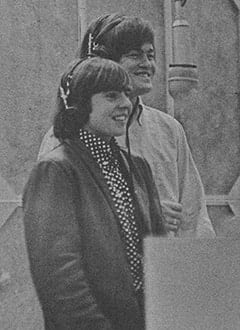
Peter is sorta like the character he plays on the show, only more intellectual. He’s kind of quiet, usually reading. Sometimes he’ll go into the studio and practice his music theory on the piano. He’s “Greenwich Village,” whatever that means… like, he comes to sessions wearing no socks, tennis shoes and an old sweatshirt. He’s a great one for quoting from books he’s read—he’ll come up with a giant quotation at the drop of a hat.
They’re all so different, really, but they mesh very nicely. Their differences make them stronger as a group, not weaker.
Changes? We haven’t noticed any. They’re just like they were when we first met them—great!!
BOYCE AND HART: By Judith Sims (songwriter and producer for no one but she can spot a groovy man with no trouble at all, and herein she spots—and even talks to—two groovy men.)
I was hurrying dwn [sic] Sunset Blvd. fearful that I was late for my interview with Boyce and Hart, when Boyce himself appeared on the same sidewalk, advancing hungrily towards a coffee shop. Even if I hadn’t recognized him as Tommy Boyce, I would certainly have noticed him—the photos should explain why. He was accompanied by a New York friend named John, and the three of us continued the hungry advance on said coffee shop. (Interviewees who feed me are almost always assured of receiving my undying devotion and gratitude… not that they want it…) Bobby Hart, also a very noticeable young man, joined us shortly thereafter.
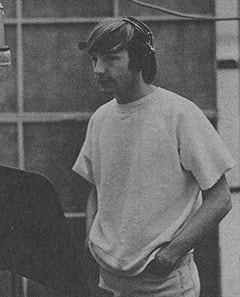
We cleaned several plates and emptied various cups and glasses, then went up to the Screen Gems Music Publisher’s office. The walnut paneled and black-leather-chaired conference room to be exact.
The Boyce-Hart background has already been set forth in a lengthy bio, courtesy of their press agent, Derek Taylor. Since I had not read this copious bio (which is always embarrassing), they patiently explained their early years.
Born at opposite ends of the country (Tommy in Charlottesville, Va., and Bobby in Phoenix, Ariz.), they met in Los Angeles. Of course. Tommy (with family) had moved to LA at age 12. Then, still in high school, he wrote “Be My Guest,” which Fats Domino recorded and rode to number one in the nation. Bobby (without family) came to Hollywood when he was 19—to be a singing star. He didn’t—but he did meet Tommy, and they started writing together on weekends. Then Tommy took off for New York, where he spent some lean, but eventually profitable, years still writing songs. Bobby, meanwhile, began touring with Teddy Randazzo’s band as a singer. When he wasn’t singing, he wrote “Hurt So Bad” with Teddy which was a hit for Little Anthony and the Imperials.
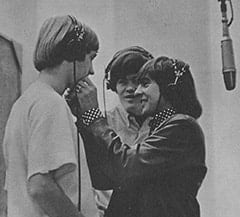
Their paths crossed again, this time in New York; and that’s when and where they really started happening. They wrote “Come a Little Bit Closer”; you may recall that Jay and the Americans recorded it. A number one song. That song prompted Screen Gems Publishing Company to hire them as composers and send them back to the West Coast. They came willingly.
Two months after they arrived they wrote and produced another hit (and there are lots more to come!): “Peaches and Cream” by the Ikettes.
“We wrote ‘Peaches and Cream’ for the Newbeats,” Tommy said, “but they decided it was too much like ‘Bread and Butter.’ We knew it was a hit song, so we decided to find a girl group to sing it; that way no one could say we were copying the Newbeats.”
Bobby explained that they got into the production end of the business by cutting demo records of their songs to show to prospective publishers or singers. “That was like producing on a small scale.”
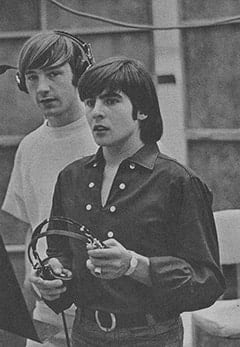
Before their bonanza with the Monkees, they also wrote and produced the themes for “Action” tv show and LA’s local “Shebang” tv show, plus working on all the Dick Clark shows. They are now “established,” to say the least. Also rich. Also very busy!
“Before, we’d get an idea, write a song, then hope to find an artist to record it. Now we do things on assignment, like an artist will have us write a song for him and produce it.”
“We produce everything we write, but everything we produce isn’t necessarily our stuff. For instance, we just finished producing a Del Shannon album for Liberty.”
“Writing still makes most of our time; we write all our songs together, but we don’t spend 24 hours a day in each other’s company. One of us usually has the initial idea, and then we work it out together. Bobby got the idea for ‘Last Train to Clarksville’ while driving to work one morning. He sang the first line or two to me, and I liked it and we started in.”

“Tommy had probably finished three-fourths of ‘She’ before he showed it to me,” added Bobby.
Both of them read music as well as write, do most if not all of the arranging, produce it—and, as if that weren’t quite enough, they’re currently working on plans to perform with a group they’ve known for some time—the Candy Store Prophets. Some of you may have seen them on recent Monkee tours. The band consists of a bass player, Larry Taylor drummer, Billy Lewis, and Bobby on organ and vocals. Tommy will join them on guitar and vocals. They’re also negotiating for a recording contract. Besides the Monkee pilot, Tommy’s voice has been heard singing the “Action” theme, but they have not yet actually recorded.
At the age of 24, they each have several gray hairs and a great deal of success.
They wear both very well.





